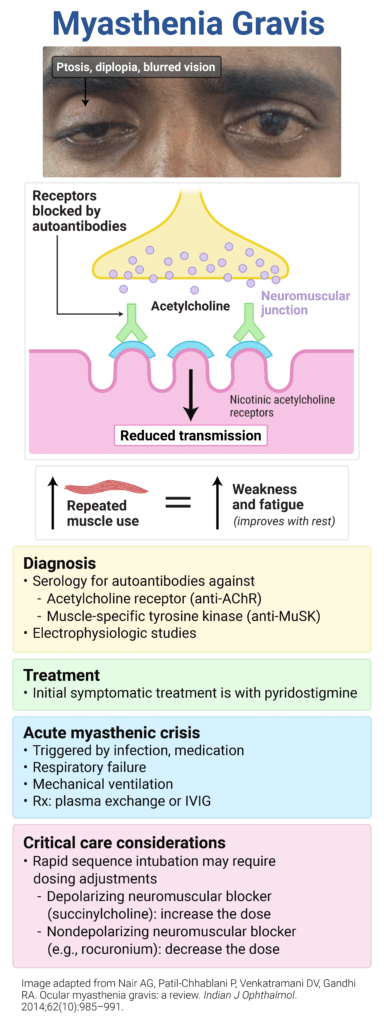Rapid Review: Myasthenia Gravis

Reviewed February 2024

Myasthenia Gravis
- Autoantibodies to nicotinic acetylcholine receptors resulting in impaired transmission at the neuromuscular junction
- Associated with thymoma, thyroid disease, autoimmune disorders
- Sx: ocular or generalized muscle weakness, bulbar weakness (dysarthria, dysphagia), ptosis and diplopia that is worse at the end of the day or following exertion
- PE: applying ice pack to eyelid improves diplopia
- Dx:
- Serologic testing for autoantibodies: anti-nAChR, anti-MuSK
- Electrophysiologic studies: repetitive nerve stimulation, single-fiber electromyography
- Tx: acetylcholinesterase inhibitors (pyridostigmine)
- Acute myasthenic crisis: plasmapheresis, IVIG
- In critical care: adjust RSI medication doses
- Increase dose of depolarizing NMB
- Decrease dose of nondepolarizing NMB
Sample Question:
A 27-year-old woman presents to the clinic concerned about eye strain. Her vision is sometimes blurry after working at a computer all day. Her boyfriend has noticed that one of her eyelids sometimes droops. Her symptoms are absent in the morning but develop and worsen as the day goes on. She has well-controlled hypothyroidism, and her only medications are levothyroxine and a combined estrogen-progestin oral contraceptive pill. She has normal vital signs. Her physical exam is remarkable for mild ptosis of the left eyelid, which becomes more noticeable with prolonged upward gaze. Which of the following is the most appropriate test to diagnose the patient’s condition?





Comments (0)